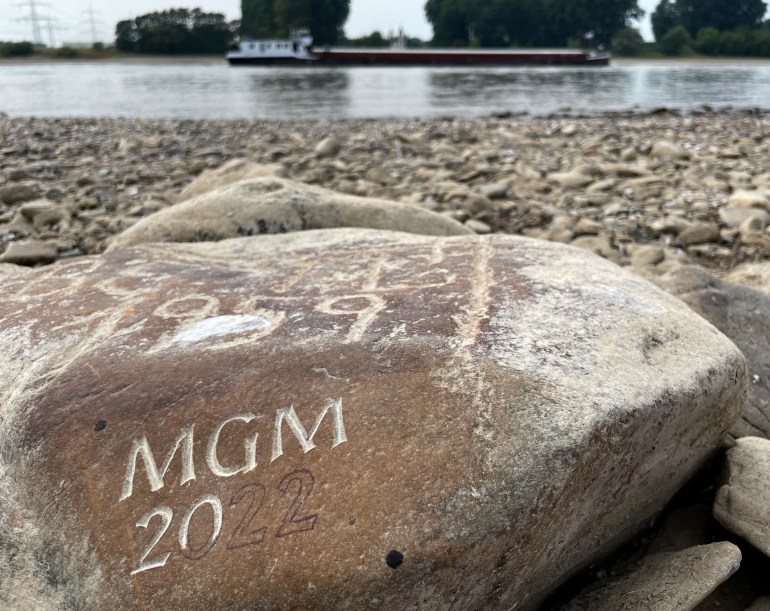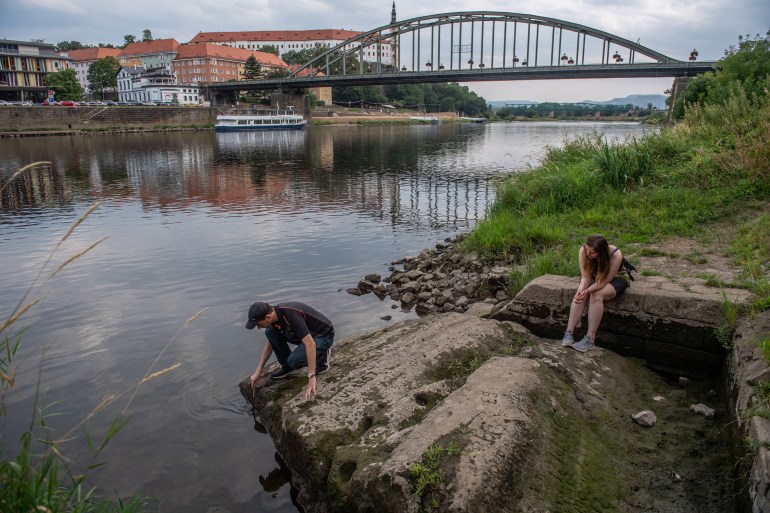‘If you see me, weep’: Hunger stones auguring drought in Europe
As water levels dropped across Europe this year, ancient river stones once again emerged to tell their centuries-old tales of despair.

As the climate crisis causes water levels to plummet, riverbeds to dry and glaciers to melt, artefacts like old warships, an ancient city, a mosque that disappeared, and human remains have emerged. This story is part of “Climate artefacts”, a miniseries telling the stories behind the people, places and objects that have been discovered due to drought and warming temperatures.
In 1904, innkeeper Franz Meyer thought of an ingenious new idea to sell beer.
Keep reading
list of 3 items‘We lived there once’: An underwater mosque resurfaces in India
Zakhiku: The ancient city in Iraq revealed by severe drought
A resident of Děčín, a trade hub on the Elbe river in present-day Czech Republic, Meyer hailed from a family of shipbuilders whose livelihoods depended on the water’s current, which had shrunk to a trickle in the summer drought.
Exposed by the low water near the town’s main suspension bridge was a huge lump of sandstone, a so-called “hunger stone”, where for centuries locals had etched markings to record the effects of drought. Thinking it would make a nice tourist attraction, Meyer chiselled the phrase “If you see me, then weep” in German, set up a beer tap, and charged visitors for the view.
Meyer’s idea was apparently enough of a success that another innkeeper in Těchlovice, just upriver, did the same. Later, in the 1930s, another stone was marked with, “Don’t cry girl, don’t whine, spray when the field is dry”, the advertising slogan of Sigma Lutín, a manufacturer of water pumps for farmers.
Since at least the early 20th century, the hunger stones found along the upper Elbe have been popular historical curiosities in times of dry weather. But they also hold valuable archival information going back more than 400 years, records compiled over generations about how people in the region experienced drought, and their dependence on the river for trade and food production.
This summer in the northern hemisphere, during a record bout of dry weather that caused record low levels in many European rivers, ship traffic slowed or was brought to a stop, and hunger stones along the Elbe and Rhine emerged once again to tell their centuries-old tales of despair. Stones appeared not just in Děčín but also in the Rhenish cities of Leverkusen and Worms, where inscriptions date mostly from the 19th and 20th centuries, and even as recently as 2009.

Although the inscribed phrases the stones are best known for are not quite as ancient as many presume, the older etchings on the stones in and around Děčín date to well before they were repurposed as tourist traps and advertising billboards.
“Usually there are initials of names and the year, sometimes there is also an engraving of the water line,” Vlastimil Pažourek,” director of Děčín’s museum, told Al Jazeera.
“In several cases, we also know who the people who engraved the inscriptions were. They owned ships or made a living by trading along the Elbe.”
The first records in Děčín are probably from the 15th century and the first legible record from 1616.
“Pointing out the dry years also had its practical meaning, drawing attention to risks for the future,” said Pažourek. “The name ‘hunger stone’ highlighted the lack of potential livelihood for the poor day labourers who towed ships and worked on them in times of drought.”
Hunger stone was not always the preferred term — other descriptions include ‘frog stone’, ‘monk stone’ and ‘strange stone’, with the first recorded instance of ‘hunger stone’ appearing in a newspaper in 1842.
From the 11th century
The Elbe rises in the Giant mountains in the Czech Republic, sweeping through Prague and northwest across the central plain of Germany, passing Hamburg just before it reaches the North Sea. At almost 1,200km (746 miles), it is one of Europe’s longest and most historically important waterways, vital to trade and agriculture since early civilisation.
Written records of droughts in the region date back as far as the late 11th century (PDF), with daily weather reports becoming available in the late 15th century. Historical sources point to disastrous social and economic effects in periods of intense dryness, including poor crops or harvests, high food prices, water shortages and even famine.

A church sermon given in Domazlice said the lack of water in 1616 — marked on the Děčín stone — had not been seen in a century. Matthaus Merian noted in his historical work, Theater Europaeum, the dry weather of 1666 in central Europe left meadows and rivers parched, caused fires in villages and forests, and forced some people to travel up to six or seven miles (10 or 11km) for water. Prayer and religious assemblies were organised to appeal for divine relief, such as on July 15, 1503, when residents of Prague were obliged to fast and pray for rain.
During the disastrously dry summer of 1842, an Elbe Commission was formed by the states of Austria, Saxony, Prussia, Anhalt, Hamburg and Denmark to describe the flow and minimum water levels required for navigation. The commission also identified and surveyed the inscriptions of hunger stones, including those at Děčín.
The hunger stones were still in use during this period, and many recorded the disastrous two decades of low water that began in 1857, which some researchers have suggested may have been caused by intensive deforestation in the region, which was industrially the most advanced region of Austria.
Works to regularise the flow of the upper Elbe intensified at the close of the 19th century, including the construction of dams, dredging and canals. In Děčín, dams would reduce the flow of water enough that its famous hunger stone remains visible for about one-third of the year.
Hydrological data
Elsewhere, the changes to the river permanently submerged some hunger stones, and others were blown to pieces because they obstructed the passage of ships.
Despite their age, the hunger stones of the Elbe still have new stories to tell. A study (PDF) published by Czech hydrological scientists in 2020 found that the stones contain more reliable hydrological data than has previously been understood.
“Traditionally, water management experts and historians … [believed] that the marks of dry years were merely commemorative records with no deeper meaning and that they were more or less randomly positioned,” the team wrote.
But the researchers found that unlike the markings on hunger stones found on other rivers, such as the Rhine or Mosel, those on the upper Elbe closely matched other evidence of the exact water levels in periods of drought.
“The aim of the mark creators was not to make commemorative inscriptions of drought but to register the exact minimum water level,” the paper read.

It was not until the early 17th century that the recording of river levels began in Europe, in Paris and the German city of Magdeburg, meaning that the Elbe hunger stones could significantly extend the data available to study the history of weather and hydrology in the region. Ancient hydrological measurements, like those on the Nile in Cairo beginning in 622, allow researchers to study historical drought and examine its correlation with global weather patterns like the North Atlantic Oscillation and El Niño–Southern Oscillations.
The effects of climate change are certain to increase the frequency of hot and dry periods in Europe in the coming decades. Drought will become more common, as will reductions in the Elbe’s flow that expose the hunger stones along its banks.
According to local legend in Děčín, there is a solution: the building of a dam downstream would flood the stone forever, and times of hunger and hardship would be gone for good.